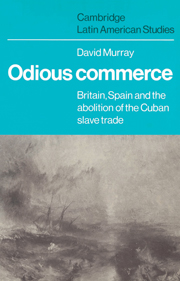Book contents
- Frontmatter
- Contents
- Tables
- Preface
- 1 The ‘opening’ of a legal trade
- 2 Parliament versus Cortes
- 3 Legality and illegality
- 4 The treaty of 1817
- 5 Enforcement and re-enforcement: the attempt to make the slave trade prohibition effective
- 6 The treaty of 1835
- 7 An abolitionist era
- 8 The Turnbull affair
- 9 The Escalera conspiracy
- 10 The penal law of 1845
- 11 Free trade and annexationism
- 12 The failure of the penal law
- 13 A new class of slaves
- 14 The abolition of the Cuban slave trade
- Abbreviations
- Notes
- Bibliography
- Index
- CAMBRIDGE LATIN AMERICAN STUDIES
5 - Enforcement and re-enforcement: the attempt to make the slave trade prohibition effective
Published online by Cambridge University Press: 16 October 2009
- Frontmatter
- Contents
- Tables
- Preface
- 1 The ‘opening’ of a legal trade
- 2 Parliament versus Cortes
- 3 Legality and illegality
- 4 The treaty of 1817
- 5 Enforcement and re-enforcement: the attempt to make the slave trade prohibition effective
- 6 The treaty of 1835
- 7 An abolitionist era
- 8 The Turnbull affair
- 9 The Escalera conspiracy
- 10 The penal law of 1845
- 11 Free trade and annexationism
- 12 The failure of the penal law
- 13 A new class of slaves
- 14 The abolition of the Cuban slave trade
- Abbreviations
- Notes
- Bibliography
- Index
- CAMBRIDGE LATIN AMERICAN STUDIES
Summary
Conflicting approaches to the implementation of the treaty, 1817—24
Two dilemmas faced the Cuban government when copies of the slave trade treaty arrived in Havana in February 1818. Genuine administrative difficulties were involved if the treaty was to be implemented. Ramírez, the Intendant of Havana, wanted to know which tribunals were to be responsible for judging cases of illegal slave trading not covered by the provisions of the treaty, specifically in connection with slavers arriving in Cuban ports after eluding capture at sea. It was clear that a contraband trade would continue and Ramírez advocated the merits of using the courts under his jurisdiction, suggesting that they be authorized to enforce the royal cédula of the previous December. The Council of the Indies ruled against the Intendant in a report to the King of 11 May 1819, in which it assigned overall responsibility for the implementation of the treaty to the Captain-General.
Far more serious were the apprehensions of Cuban planters and merchants who foresaw a catastrophe for Cuba if the treaty was fully implemented. The catastrophe they feared was economic, although there were other dangers as well. Even the publication of the royal cédula was resisted on the grounds that it might set off a chain reaction among the slaves. The Captain-General was forced to adopt a compromise formula, publishing the cédula only in the newspapers of Havana, and communicating it to the rest of the island through the various lieutenant-governors. At first the merchant and planter groups in Cuba expressed their opposition tentatively.
- Type
- Chapter
- Information
- Odious CommerceBritain, Spain and the Abolition of the Cuban Slave Trade, pp. 72 - 91Publisher: Cambridge University PressPrint publication year: 1981



